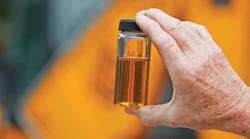Hydraulic Oil Cleanliness And Contamination Control: Not All Machines Are Equal
I have for many years asserted that hydraulic oil cleanliness is no longer THE most critical preventative maintenance issue. There are two reasons for this: the first is the word has been so widely preached over such a long period of time that even those who haven't being paying attention have heard the message. And secondly, modern advances in filtration technology and their widespread adoption means that most hydraulic equipment begins life much better equipped for controlling contamination than it used to.
HOWEVER, this is not to say oil cleanliness and contamination control are no longer important, or something you can forget about. Just that most hydraulic equipment users start with a greater awareness than they do with other maintenance issues, which garner much less attention.
And how much attention you pay to contamination control, or any other maintenance routine, does depend, in part at least, on what TYPE of hydraulic equipment you own or operate. One of my Hydraulics Pro Club members from Canada, Doug Bleackley recently shared this revelation:
"I now own and operate a concrete pump and these animals are 100% about hydraulics, and they are built with close tolerances. I used to operate loaders, crushers and trucks in the gravel industry, and I wonder how we got away with the abuse we put the hydraulic systems through on those machines."
As far as technologically sophisticated mobile hydraulic equipment goes, modern concrete pumps are right up there. Plus, they have this built-in contamination ingression system, which is the unavoidable interface between the concrete and the hydraulics. And when you consider the component parts of concrete - namely water and grit, you have the contamination equivalent of the perfect storm -- should it get in, and it seems to manage to do so.
So yes, Doug has gone from a Minor League player to the Big League, so to speak. But others have walked this path before. This morning I had a conversation with another of our members from the east coast of Australia, David Austen, who is responsible for a fleet of 20 concrete pumps.
David has instigated a routine whereby at day's end, one of the machines is hooked up to a filter cart overnight. This occurs on a continuous rotation, so that each machine is put on 'dialysis' at least once every 4 weeks. As you'd expect, this routine has markedly improved oil cleanliness levels across the entire fleet. And according to David, reliability has increased to the point where an in-service breakdown is a rare occurrence.
Is this a strategy you should swipe and deploy on your hydraulic equipment? Because not keeping the oil clean can be a costly mistake. And to discover six others you want to be sure to avoid, get "Six Costly Mistakes Most Hydraulics Users Make... And How You Can Avoid Them!" available for FREE download here.

